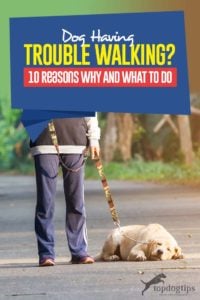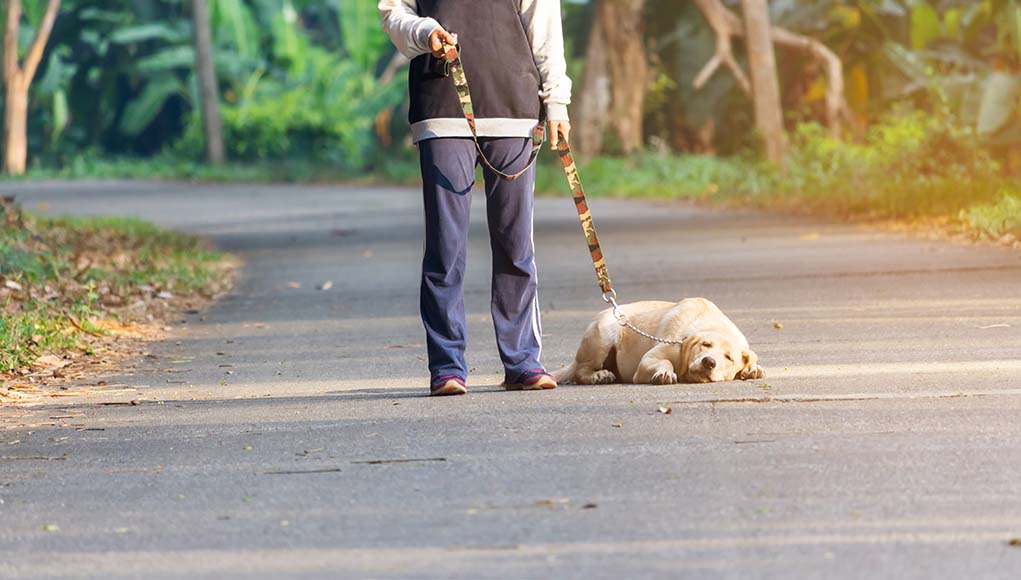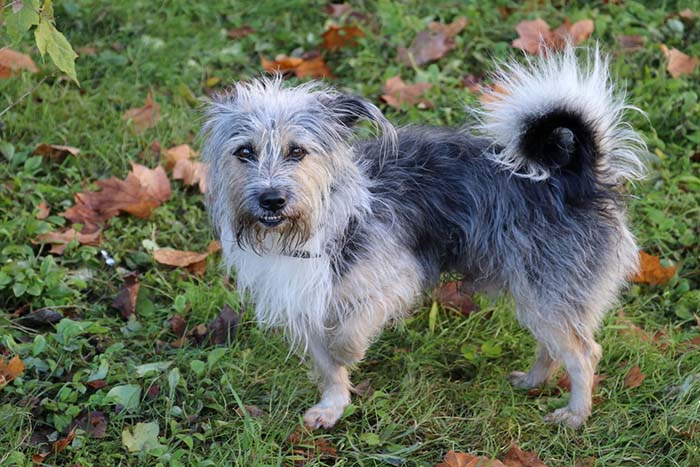It can be discouraging, frustrating, and even frightening for owners when they notice their dog having trouble walking. This can be caused by a number of behavioral issues and medical conditions. Below is a list of these causes, and steps that can be taken to remedy these the issues.
Behavioral Causes
1. Pulling
This is a common issue that dog owners face. Many dogs want to run, instead of walk.
Set them free. One way to address this issue is to let the dog run, by way of the owner running with their dog, wearing roller blades or riding a bike alongside the running dog. Allowing a dog to run, and fully get their energy out, is imperative to their physical and mental health.
Special harness. If moving quickly alongside the dog is not something you'd would like to do, or unable to do, there are dog collars and especially no-pull harnesses that are meant to help prevent a dog from pulling while walking on a leash. But any collar that uses painful methods of controlling a dog (such as prong collars or choke chains) are no longer recommended by pet trainers, behaviorists, or veterinarians because they have been proven to cause more harm than good.
Training. It is helpful to initially train a dog on how to properly walk with a leash, in a calm and boring environment, such as inside the dog owner’s home and private yard.
Be consistent. Train a dog daily, multiple times each day, and always reward the dog with much praise and high-value treats (positive reinforcement) when she or he walks properly on their leash.
Steady progress. Once the dog is consistently doing well walking on a leash in your home and yard, gradually move walks outward, to more exciting areas, starting with the sidewalk, then a nearby trail, so on and so forth. Making sure to always stop to reward the dog with positive reinforcement for doing well, and gently correct the dog (but never punish) when he or she is not doing well.
Read more about this topic in the following article written by certified professional dog trainer, Annie Phenix (CPDT-KA), 5 Dog Walking Problems and Solutions.
2. Overreacting to / Lunging at Other Dogs
It is not uncommon for dogs to react to other dogs. sometimes aggressively.
Correct them. Bringing your dog's attention to the issue and correcting the dog immediately, consistently, and properly are the key aspects to solving this problem.
Commands. Before taking a dog out on leash, teach and practice the most common basic dog obedience commands that will get the dog to stop immediately, and pay attention to you the owner.
Proper timing. When on a walk, a dog owner must wait until their dog notices another dog to react (and must never react preemptively or negatively to another dog), once the dog notices the other dog, use a well-taught command to make the dog stop and pay attention to owner, and reward dog with a high-value treat so he or she associates seeing other doings, with getting treats. Do not punish a dog, as it will reverse all of the training that has been done.
Behave yourself. As mentioned above, if an owner reacts negatively to other dogs that are approaching their dog’s path, preemptively, the owner’s dog will sense the anticipation for something bad to happen, and will react to the ways in which the owner is feeling and reacting.
Be confident. You must remain calm, cool, and collected at all times around their dog and other dogs. The owner must be firm yet calm while giving corrections to the dog, making sure to keep their head up and shoulders back, because a dog will determine how their owner is feeling based on their body language and tone of voice.
Exact actions. Never yank or drag a dog around by their leash or collar. This will negate any training that has taken place and cause a dog to lose trust in their owner. The more an owner properly trains a dog on how to interact with other dogs, and the more socialization that a dog has, the better he or she will become at not overreacting to or lunging at other dogs that cross their path.
Read more about how to address this dog walking issue in the following article published by the Animal Humane Society, Managing a Leash-Reactive Dog.
3. Distracted Walk and Stopping
Most dogs like to stop frequently on walks in order to sniff out every new scent that they encounter, and some dogs also like to mark their territory.
Pay attention. In order to have a dog pay attention to their owner, the owner must always pay attention to the dog, and focus their attention on fully engaging the dog during walks.
Short leash. You should keep the leash short, and close to their body (but not tight or painful to the dog) in order to minimize distractions. Best use use a harness rather than collar.
Equipment. If you have to use a collar, then make sure to use the leash-collar combo to keep your dog’s head up in the air, instead of close to the ground, where many sniff-worthy distractions exist.
Obedience. Teach a dog the “Look” “Leave It” and “Let’s Go” commands, in calm environments at home, by administering high-value treats (cheese, peanut butter, hot-dogs, chicken, etc.) to the dog each time she or he follows the commands, and practice this often before taking the dog out on walks that have many distractions
Conditioning. It is also important to consistently reward your dog for staying on the path, and not getting distracted for certain periods of time during walks, by allowing he or she to take short breaks, periodically, in which they are positively rewarded by being allowed to sniff everything and go potty.
Read more about this issue, and how to correct it in the following article written by dog trainer, Christie Canfield, Tips for Walking Your Distracted Dog.
4. Not Interested in Walking
This issue appears most commonly in puppies where a young pup is more likely to get confused about leaving their new home, as well as become tired quickly and easily, causing the pup to sit down mid-walk and refuse to move. This problem is also seen in adult dogs that are fearful or uncomfortable, and those who have not been exposed to walking.
Home preparations. Because wearing a collar can be uncomfortable for a puppy, at first, it is helpful to have the pup wear their collar around the house a few times before beginning leash training (must be done with constant supervision so the puppy does not get caught on anything). Better yet, use a puppy harness instead.
Show them how. Help a young dog learn how to properly walk on leash by picking the puppy up and carrying them a short distance away from their home, then turn back towards the home and let the puppy walk back on the leash. Puppies will be more motivated to walk towards their home than away from it. Use positive reinforcement by rewarding the puppy with high-value treats periodically, as they walk on the leash correctly.
Give them time. It is important that dog owners never overexert their dogs, both young and old. If a dog is panting and sitting or lying down on a walk, allow the dog adequate time to rest in the shade, and always have fresh water available for a dog to drink during the walk. If a dog seems too exhausted to walk, even after a good amount of resting, it is important that the dog’s owner carry he or she back to the car or home. Dogs will not fake being over-exhausted, if they are acting this way it is because they have reached their limit and owners should not to push them, because injuries or heat-exhaustion could occur.
Specific training. For dogs that are fearful, it is important to use exposure therapy, but very gradually, by taking the dog on walks in calmer places, during non-peak hours, in which fewer people and animals are likely to be out, and around the area in which the dog is being walked, and always use positive reinforcement to reward the dog for walking on a leash.
Types of collars. Oftentimes dogs become uncomfortable when wearing a collar and being led on a leash. Owners should always use the lightest collars and leashes possible for their pets and it is no longer recommended by dog trainers or veterinarians to use pain-inflicting training collars as these types of devices have been proven to cause more harm than they help.
Medical reasons. A dog could be experiencing physical pain due to an injury or disorder that has not been diagnosed if they refuse to walk despite addressing all other issues and using light and comfortable walking gear. If this happens, it is best to have the dog seen by a licensed veterinarian in order to determine if the dog is experiencing physical pain.
Read more about this issue and ways to resolve it in the following article written by dog trainer, Victoria Schade, 6 Reasons Your Dog Refuses to Walk and How to Help.
Medical Reasons
Each of the conditions included in the list found below should be diagnosed by your veterinarian who can also provide answers regarding potential treatments and what can be done to help a dog with each of these conditions.
5. Arthritis
This is among the most common reasons that dogs, especially older dogs, have trouble walking when experiencing all kinds of pain and discomfort. It is a chronic and degenerative disorder that is caused by everyday use of your dog’s joints.
6. Back Problems
Any back problems, but specifically those that directly impact the spinal cord, can cause a dog to have trouble walking. Back problems in dogs include but are not limited to degenerative myelopathy, intervertebral disk disease, fibrocartilaginous embolic myelopathy, vertebral instability or wobbler syndrome.
7. Cancer
Most commonly seen in older dogs; tumors, both benign and malignant, can negatively impact a dog’s ability to walk.
8. Injury
A number of injuries that a dog can sustain, such as fractures, sprained muscles, or torn ligaments, can cause damage to the dog’s bones, muscles, or joints, resulting in he or she having trouble walking.
9. Neurological Conditions
 There are a multitude of neurological issues that can result in a dog having trouble with walking. Including lumbosacral stenosis, strokes, infections such as meningoencephalitis, botulism infection, and certain kinds of toxic poisoning that can lead to debilitating neurological conditions.
There are a multitude of neurological issues that can result in a dog having trouble with walking. Including lumbosacral stenosis, strokes, infections such as meningoencephalitis, botulism infection, and certain kinds of toxic poisoning that can lead to debilitating neurological conditions.
10. Orthopedic Conditions
There are a wide-variety of orthopedic conditions that can cause a dog to have a difficult time walking. Including hip and elbow dysplasia which is frequently seen in giant breeds of dogs, as well as rupture of the anterior cruciate ligament or cranial cruciate ligament.
READ NEXT: 8 Tips on How to Train a Dog Not to Run Away and Safely Walk Off-leash














